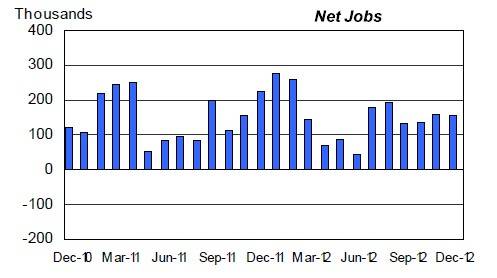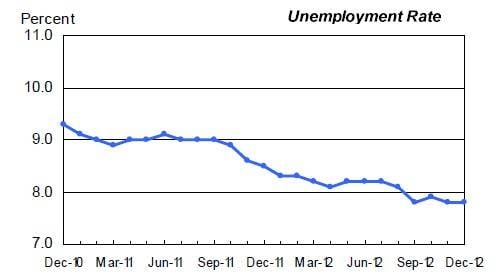Original URL: https://www.theregister.com/2013/01/04/us_jobs_report_dec_2012/
IT sector bumped up jobs in the US in December
Computer design hot, chip making not so much
Posted in On-Prem, 4th January 2013 18:02 GMT
Economists had been worried that late October superstorm Hurricane Sandy, which didn't show an immediate effect on the employment situation in November, would wallop job creation in December. Because of this, they predicted, the Bureau of Labor Statistics might have to go back and revise its November figures downwards when the December report was issued today.
As it turns out, the US economy was growing fast enough as 2012 was ending to withstand the effects of the storm.
According to the latest jobs report (PDF) from the BLS, which is a division of the US Department of Labor that monitors all things related to jobs and wages, the US economy added 155,000 net new workers. This was in spite of the hurricane's very real downward effects on jobs in New Jersey and to a lesser extent in New York, Connecticut, and Pennsylvania, which bore the brunt of the superstorm and the political wrangling over the federal budget in the US Congress and the looming "fiscal cliff." Those are net new jobs outside of farms, which are tracked separately by the BLS and which are subject to their own cycles outside of those in the rest of the economy.
The private sector added 168,000 workers in December, according to the BLS, while governments at the local, state, and federal levels resumed their slashing after a brief pause in November to cull 13,000 people from the payrolls.
The BLS actually revised its November figures upwards, not downwards, and now believes the US economy added 161,000 net new workers in November, up from the 146,000 it originally projected, but trimmed its October number by 1,000 workers to 137,000. All in all, this is a pretty good run for the three months.

The US economy has created jobs every month since October 2010
In fact, the US economy has not cut workers on a net basis since September 2010, and as you can see from the chart above, the average has been on the order of 150,000 jobs per month since October 2010. This is not close to the 200,000 or so jobs necessary to keep up with population growth and pales compared to the many hundreds of thousands of jobs – 500,000 to 800,000 per month – lost during the worst parts of the Great Recession. The figures also don't take into account around 7 million workers who want jobs but have stopped looking as well as another 12.2 million who are looking for full-time work and either can't find any job or have accepted part-time work.
None of these statistics ever talk about how many people have two jobs, by the way, which is necessary for a lot of people to make ends meet.
Based on surveys of households, the BLS reckons that the unemployment rate is 7.8 per cent, which is that 12.2 million divided by the 156.4 million-strong labor pool.

The US unemployment rate holds steady as displaced workers re-enter the workforce
In the November jobs report, the BLS reckoned that the unemployment rate was 7.7 per cent, but this has been revised up as well - to 7.8 per cent. To some, this means the unemployment rate has ticked up, to others it means it is flat. The important thing as that the labor pool is expanding more or less in synch with the jobs creation, even if the pace of job creation is not as aggressive as it would need to be to really make a dent in the unemployment rate. Given the state of the housing market in the US, which makes it hard for people to pick up and move to a new job, and the jitteriness of the US economy itself, it is not surprising that a new structural unemployment level just under 8 per cent is prevailing. In the last recovery just ahead of the Great Recession, which started in December 2007, the structural unemployment rate was reckoned by economists to be around 4.5 per cent. No one thinks the level of structural employment is that low any more.
As you might expect, the leisure sectors in the US added lots of jobs during the holiday season. Food and drinking establishments added 38,000 workers in December, above the average of 24,000 per month throughout 2011 and 2012. Retailers already added jobs in October and November to prepare for the slightly earlier Thanksgiving holiday, so the retail sector was flat in December, and everybody is bracing for layoffs in early 2013 as people cut back on shopping. The construction sector added 30,000 jobs, the manufacturing sector added 25,000 jobs, and the healthcare sector added 45,000 in December.
As important as jobs are, the number of hours that people are working is on the rise, as is the hourly pay rate, compared to a year ago, which increases the purchasing power of workers in the US and has an expansive effect on the economy. This is also an indication that we are possibly closing in on a new structural unemployment level until the US economy expands much faster than it currently is doing.
The BLS doesn't track jobs by title, but we can create a proxy for the IT industry (and not necessarily a very good one) by drilling down into the raw data put out by Uncle Sam for areas we know have an IT component.
Within the manufacturing sector, computer and electronic products makers added 4,500 workers in December, for a total of just under 1.1 million workers. Within this group, computer and peripheral equipment makers added 1,000 jobs, reaching a total of 164,500, and communications equipment makers added 400 net new employees, to 107,000 workers. Semiconductor and electronic component makers boosted their payrolls to 383,300, an increase of 1,300 people compared to November. Communication gear and chip makers have, however, have collectively chopped over 10,000 jobs in the past year, so these gains have a long way to go to fill in the gaps. (It may never happen if chip design and manufacturing is offshored.)
In the information sector, which includes all kinds of media, telecom, and broadcasting as well as data center hosting, employment among telecom companies fell by 1,700 to 830,800 workers, while data processing, hosting, and related services companies added 600 to a total of 242,200 employees.
As has been the case throughout most of the recovery in the wake of the Great Recession, companies performing computer systems design and related services, which account for a little less than a tenth of the overall employment in the professional and business services sector, continued to add jobs in December. Total employment in the computer systems design area was 1.62 million, up 3,900 from November. Management and technical consulting services firms, which often have work that has an IT component, added 10,000 workers in December and now employ 1.17 million workers. ®